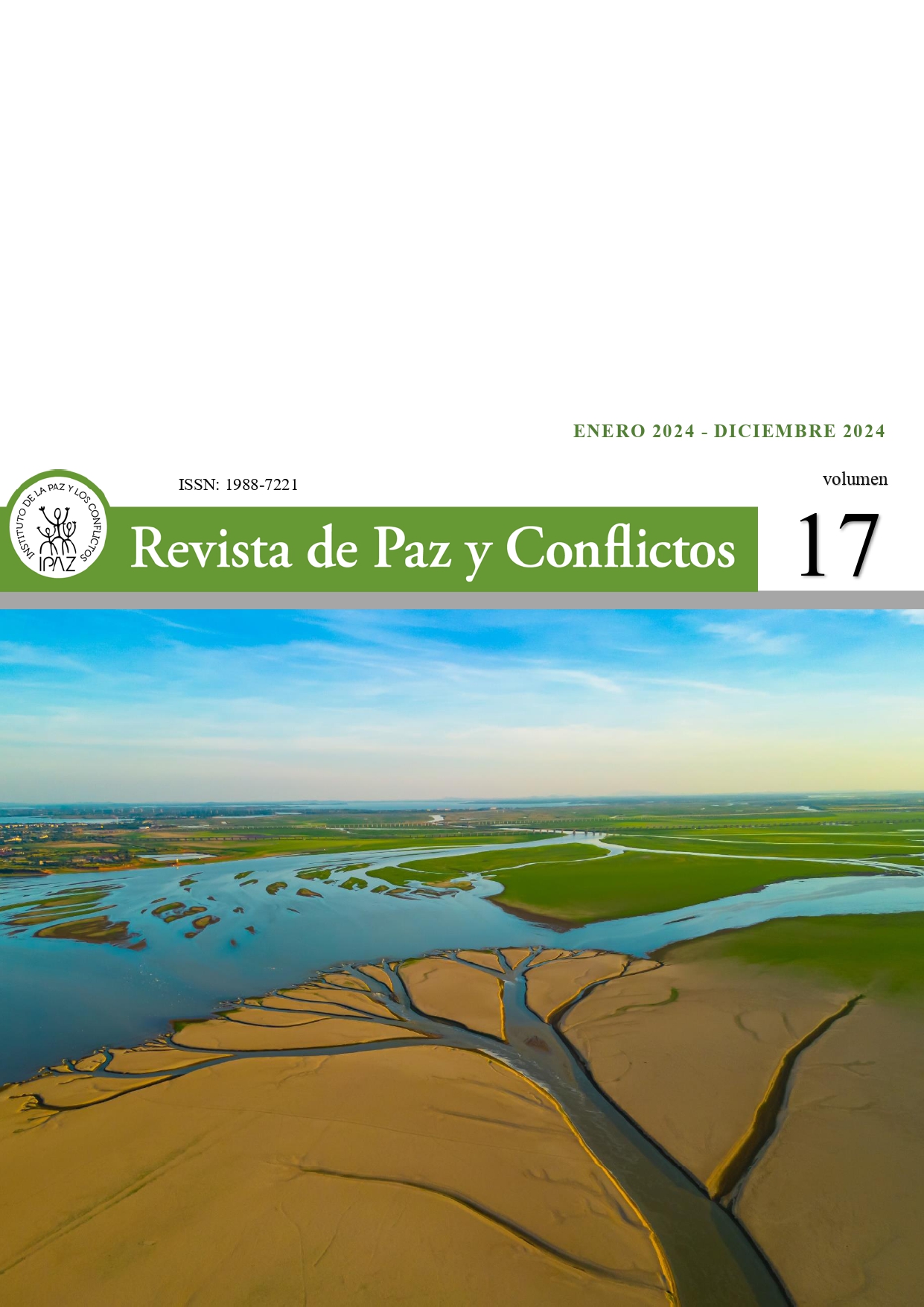Flujos comerciales y conflictos: la trayectoria del comercio y gestión del sándalo indio (ss. XVI-XX)
DOI:
https://doi.org/10.30827/revpaz.17.32543Palabras clave:
China, commodities, conflictos, flujos comerciales, Historia Ambiental, india, sándaloResumen
La rareza y protagonismo cultural del sándalo (Santalum sp.) en distintas partes del mundo, ha hecho de esta especie uno de las commodities (materias primas) más importantes del mercado asiático, llevando a varios grupos a desarrollar gran cantidad de expresiones culturales a partir de una madera que no crece en sus territorios, como ha sido el caso chino. A través de su particular ecología y distribución, hemos podido identificar una serie de focos de producción del sándalo a nivel histórico siendo la India uno de ellos. De esta manera, se han constituido extensas redes de intercambio, además de esfuerzos por controlar estos lugares y su producción. Este fenómeno se intensificará con la llegada de los agentes occidentales a Asia en el siglo XVI que, en búsqueda de los beneficios del comercio con China y hasta bien entrado el siglo XX, intentarán establecer regímenes de control y monopolio allá donde el sándalo crecía. En este artículo, partiendo de la naturaleza e importancia del sándalo, nos centraremos en la experiencia india bajo la óptica de la historia ambiental, explicando la reorientación de su producción hacia China e identificando la sucesión de los diferentes regímenes de gestión y comercio a los que se sometió al árbol, pudiendo contextualizar su importancia en distintos procesos históricos y como especie.
Descargas
Citas
Ahuja, R. & Christof-Füchsle, M. (2020). A Great War in South India: German Accounts of the Anglo-Mysore Wars, 1766–1799. De Gruyter Oldenbourg. https://doi.org/10.1515/9783110644647.
Ali, B. S. (1982). Tipu sultan a study in diplomacy and confrontation. Geetha Book House.
Amirthalingam, M. (2016). Sacred Groves of India— An Overview. International Journal of Current Research in Biosciences and Plant Biology, 3(4), 64-74. http://dx.doi.org/10.20546/ijcrbp.2016.304.011.
Anh Thuan, T. & Nguyen, T. V. L. (2022). Trade of the Portuguese Royal and Private Traders in India from the 16th to the 19th Century. Vestnik of Saint Petersburg University. Asian and African Studies, 14(4), 704-715. https://doi.org/10.21638/spbu13.2022.409.
Arunkumar, A. N., Joshi, G. & Mohan Ram, H. Y. (2012). Sandalwood: History, uses, present status and the future. Current Science, 103(12), 1408-1416.
Arunkumar, A. N., Joshi, G., Warrier, R. R. & Nataraja Karaba, N. (2022). Indian Sandalwood: A Compendium. Springer. https://doi.org/10.1007/978-981-16-6565- 3.
Arunkumar, A.N., Dhyani, A. & Joshi, G (2019). Santalum album. The IUCN Red List of Threatened Species 2019. [En línea]. https://www.iucnredlist.org/species/31852/2807668 [Consultado el 11/01/2025].
Barbosa Chacón, J. W., Barbosa Herrera, J. C. & Rodríguez Villabona, M. (2013). Revisión y análisis documental para estado del arte: Una propuesta metodológica desde el contexto de la sistematización de experiencias educativas. Investigación bibliotecológica, 27(61), 83-105.
Bhat, N. S. (2008). Political interaction between Portuguese Goa and Karnataka. Portuguese Studies Review, 16(2), 25-50.
Boehm, C. (2005). Concept of Danzō: “Sandalwood Images” in Japanese Buddhist Sculpture of the 8th to 14th Centuries. [Tesis Doctoral, School of Oriental and African Studies, University of London]. ProQuest.
Boxer, C. R. (1959). The Great Ship from Amacon: Annals of Macao and the Old Japan Trade, 1555-1640. Centro de Estudios Históricos Ultramarinos.
Buchanan, F. (1988). A journey from Madras through the countries of Mysore, Canara, and Malabar (Vol. I.) Asian Educational Services.
Chandran, M. D. S., Gadgil, M. & Hughes. J. D. (1998). Sacred groves of the western gahts of India. Conserving the Sacred for Biodiversity Management, 10(8), 210- 231.
Chung, T. (1973). The Britain-China-India Trade Triangle (1771-1840). Proceedings of the Indian History Congress, 34, 77-91.
Cottrell, C. A. (2002). Splinters of Sandalwood, Islands of ’Iliahi: Rethinking Deforestation in Hawai’i, 1811-1843 (Publicación Nº 3024) [Tesis Doctoral, Hawai’i University]. Scholar Space.
Cullen, L. (2017). The Nagasaki Trade of the Tokugawa Era: Archives, Statistics, and Management. Japan Review, 31, 69-104.
Da Orta, G. (1913). Colloquies on the simples & drugs of India (Melo, F. M. Ed. & Markham, C. R. Trad.). H. Sotheran and co.
Ehrlich, P. R., & Ehrlich, A. H. (1995). Extinción: La desaparición de las especies vivientes en el planeta (Vol. I). Salvat.
Espinoza Baca, P. (2002). Reflexiones en Torno a Las Bases Metodológicas de los Estudios Histórico-Ambientales. SOCIOTAM, 12(2), 65-86.
Fisher, M. H. (2018). An Environmental History of India: From Earliest Times to the Twenty-First Century. Cambridge University Press.
Gadgil, M., & Guha, R. (1992). This fissured land: An ecological history of India. Oxford University Press.
Ganeshaiah, K. N., Uma Shaanker, R. & Vasudeva, R. (2007). Bio-resources and empire building: What favoured the growth of Vijayanagara Empire?. Current Science, 98(2), 140-146.
Guha, R. (1983). Forestry in British and Post-British India: A Historical Analysis. Economic and Political Weekly, 18(44), 1882-1896.
Gunn, G. C. (2016). The Timor-Macao Sandalwood Trade and the Asian Discovery of the Great South Land?. Review of Culture, 53, 125-48.
Hägerdal, H. (2007). Rebellions or factionalism? Timorese forms of resistance in an early colonial context, 1650-1769. Bijdragen tot de Taal-, Land- en Volkenkunde, 163(1), 1-33.
Hasan, M. (1971). History of Tipu Sultan (2ª ed.). The World Press Ltd.
Jones, R. T. (2014). Cap 6. The Environment. En Armitage, D. & Bashford, A. (Eds.), Pacific Histories: Ocean, Land, People (pp. 121-142). Red Globe Press.
Jyothi, R. (2019). The Trade and Trade-guilds in Vijayanagar Empire. International Journal of Social and Economic Research, 6(2), 26-30.
Kausar, K. (1980). Secret Correspondence of Tipu Sultan. Light and Life Publishers. Linsheng, C. (2022a). Sandalwood and Buddhism: A Perspective of Material Culture. Journal of the Pakistan Historical Society, 70(3), 7-22.
Linsheng, C. (2022b). Sandalwood and Human Beings: A Perspective of Environmental History. Journal of Development and Social Sciences, 3(3), 304-316. https://doi.org/10.47205/jdss.2022(3-III)30.
Liu, X. & Lin, M. (2017). 明代宫廷香料来源与消费述论 [Un Debate sobre las Vías y Consumo de Especias en Palacio durante la Dinastía Ming]. 故宫博物院院刊 [Revista del Museo Palacio], 6, 38-51.
Lobato, M. (2014). Luso-Eurasian Influence in Timor (Early Sixteenth to the Mid- nineteenth Century). Journal of Asian History, 48(2), 165-203. https://doi.org/10.13173/jasiahist.48.2.0165.
Loneragan, O. W. (1990). Historical review of sandalwood (Santalum spicatum) research in Western Australia. Research Bulletin-Department of Conservation and Land Management Western Australia, 4.
Mahalingam, T. V. (1940). Administration and Social life under Vijayanagar. University of Madras.
Mahalingam, T. V. (1951). Economic life in the Vijayanagar Empire. University of Madras.
Mathew, J. (2019). Colonial Exploitation of Forest Resources of the Western Ghats: 1792–1882. Proceedings of the Indian History
Congress, 80, 591-599.
Mathew, K. S. (1983). Portuguese Trade with India in the Sixteenth Century. Manohar.
McHugh, J. (2013). Sandalwood and carrion: Smell in premodern Indian religion and culture. Oxford University Press.
McLellan, R. & Watson, D. (2022). The living dead: Demography of Australian sandalwood in Australia’s western rangelands. Austral Ecology, 47, 1549-1709. https://doi.org/10.1111/aec.13243.
Mohankrishna, R. K. (2003). Portuguese Hegemony over Mangalore. Proceedings of the Indian History Congress, 64, 614-621.
Morrison, K. D (1995). 13. Agricultural Intensification and Vijayanagara: An Overview. En Srinivasan, L. K. (Ed.), Sri Nagabhinandanam. Dr. M. S. Nagaraja Rao Festschrift: Essays On Art, Culture, History, Archaeology, Epigraphy (pp. 145-156). M. S. Nagarajsa Felicitation Committee.
Oakley, E. (2020). “Very Dull & No Business Doing”: A Reassessment of the American Sandalwood Trade between Hawaii and China, 1790-1832. Configurações. Revista Ciências Sociais, 26, 63-81. https://doi.org/10.4000/configuracoes.10036.
Ortega Santos, A. (2023). Sures Socioambientales. Narrativas epistemológicas. Librería CLACSO.
Page, T., Sacaio, M., Almeida, L., da Costa, L., Pereira, I. & Williams, R. (2018). Sandalwood production and Hosts in Timor-Leste. Ai-Com.
Poralla, V. & Srivastava S. (2020). Prominence of Sandalwood (white and red) handicraft in the interiors with respect to aromatherapy. International Journal of Advance Research, Ideas and Innovations in Technology, 6(5), 431-437.
Prakash, O. (1998). European Commercial Enterprise in Pre-Colonial India. Cambridge University Press.
Rajsmita, B. & Keshavamurthy, V. (2019). Re-discovering Sandalwood: Beyond Beauty and Fragrance, Indian Dermatology Online Journal, 10(3), 296–297. https://doi.org/10.4103/idoj.IDOJ_357_18.
Rashkow, E. (2014). Perfumed the axe that laid it low: The endangerment of sandalwood in southern India sandalwood in southern India. The Indian Economic & Social History Review, 51(1), 41-70. https://doi.org/10.1177/0019464613515553.
Reid, A. (1995). Humans and Forests in Pre-colonial Southeast Asia. Environment and History, 1(1), 93-110.
Roever, A. D. (2002). De jacht op sandelhout: De VOC en de tweedeling van Timor in de zeventiende eeuw. Walburg Press.
Sandeep, C. & Manohara, T. N. (2019). Sandalwood in India: Historical and cultural significance of Santalum album L. as a basis for its conservation. NeBIO, 10(4), 235-242.
Saravanan, V. (2008). Economic exploitation of forest resources in south India during the pre-Forest Act colonial era, 1793-1882. The International Forestry Review, 10(1), 65-73.
Sarup, S. (2016). Forests of India: A Review of its Colonial Ordeal. International Journal of Research in Humanities and Social Studies, 3(3), 40-43.
Seenaiah, E. (1987). Some Aspects of the Agrarian Economy and Trade in the Vijayanagar Empire [1500-1600]. Proceedings of the Indian History Congress, 48, 271-274.
Shineberg, D. (1967). They came for sandalwood; a study of the sandalwood trade in the south-west Pacific, 1830-1865. Melbourne University Press.
Shukla, S. K. (1981). Horse Trade in Medieval South Its Political and Economic Implications. Proceedings of the Indian History Congress, 42, 310-317.
Sinopoli, C. M. & Morrison, K. D. (1995). Dimensions of Imperial Control the Vijayanagara Capital. American Anthropologist, 97(1), 83-96.
Sivaramakrishnan. (1995). Colonialism and Forestry in India: Imagining the Past in Present Politics. Comparative Studies in Society and History, 37(1), 3-40.
Sridharan, M. P. (1984). Tipu’s Letters to French Officials. Proceedings of the Indian History Congress, 45, 503-508.
Stein, B. (1989). Vijayanagara. Cambridge University Press.
Sultan, M. A. (2001). State & Diplomacy under Tipu Sultan: Documents and Essays (Irfan, H. Ed.). Tulika.
Talbot. (1982). A Brief History of the Sandalwood Industry of Western Australia. Western Australia Forests Department.
Thomson, L. A. J. (2020). Looking ahead— global sandalwood production and markets in 2040, and implications for Pacific Island producers. Australian Forestry, 83(4), 245-254. https://doi.org/10.1080/00049158.2020.1841441.
Tipu, F. A. (1811). Select letters of Tippoo Sultan to various public functionaries (Kirkpatrick, W. Trad.). Black, Parry, and Kingsbury.
Underwood, J. (1954). A History of the Sandalwood Industry of Western Australia [Tesis, Claremont Teacher's College]. Department of Biodiversity, Conservation and Attractions.
Van Dam, P. J. E. M. & Verstegen, S. W. (2009). Environmental History: Object of Study and Methodology. En Boersema, J. J. & Reijnders, L. (Eds.), Principles of Environmental Sciences (pp. 25-31). Springer Netherlands. https://doi.org/10.1007/978-1-4020-9158-2_4.
Van Dyke, P. A. (2016). Merchants of Canton and Macao: Success and Failure in Eighteenth-Century Chinese Trade (1ª ed.). Hong Kong University Press.
Villiers, J. (2001). Great Plenty of Almug Trees: The Trade in Southeast Asian: Aromatic Woods in the Indian Ocean and China, 500 Bc -Ad 1500. The Great Circle, 23(2), 24-43.
Viswanath, S., Lubina, P., Subbanna, S. & Sandhya, M. (2018). Traditional Agroforestry systems and practices: A review. Advanced Agricultural Research & Technology Journal, 2(1), 18-29.
Voytishek, E. E. (2022). Cultural Transfer into the Future: Time Measurement with Incense in East Asia. En The Fourth Tohoku Conference on Global Japanese Studies Precarity in an Inter-connected Northeast Asia (pp. 61-69). Tohoku University.
Wade, G. (2009). An Early Age of Commerce in Southeast Asia, 900-1300 CE. Journal of Southeast Asian Studies, 40(2), 221-265.
Weidong, G. (2015). 檀香木: 清代中期以前国际贸易 的重要货品 [El sándalo: Un importante artículo comercial antes de mediados de la dinastía Qing]. Studies in Qing History. [En línea] http://iqh.ruc.edu.cn/qdzwgxyj/zwgx_yjqy/my/63292c7d66e34387918240b45b26c49f.htm [Consultado el 11/01/2025).
Weil, B. (2006). Conservation, Exploitation, and Cultural Change in the Indian Forest Service, 1875-1927. Environmental History, 11, 319-343.
Woodside, A. (2003). 5. The Ch’ien-Lung Reign .En Peterson, W. J. (Ed.) The Cambridge History of China: The Ch’ing Empire to 1800 (Vol 9.1) (pp. 230-299). Cambridge University Press.
Wu, L. (2021). 英帝国扩张与地方资源博弈—18 世纪印度迈索尔檀香木入华贸易始末探析 [Imperialismo Británico y Recursos Locales, el Comercio Indio de Mysore de sándalo con China durante el siglo XVIII]. 自然辩证法通讯 [Revista de las Dialécticas de la Naturaleza], 43(5), 15-20.
Descargas
Publicado
Cómo citar
Número
Sección
Licencia
Derechos de autor 2025 Revista de Paz y Conflictos

Esta obra está bajo una licencia internacional Creative Commons Atribución 4.0.
Esta obra está bajo una licencia internacional Creative Commons Atribución 4.0.














